Samsung Galaxy S 2 (International) Review - The Best, Redefined
by Brian Klug & Anand Lal Shimpi on September 11, 2011 11:06 AM EST- Posted in
- Smartphones
- Samsung
- Galaxy S II
- Exynos
- Mobile
GLBenchmark 2.1 Solves Our Resolution Problems
Modern Android smartphones either run at 800 x 480 (WVGA) or 960 x 540 (qHD). The iPhone 4 features a 960 x 640 (DVGA) display, while the iPad 2 has a 1024 x 768 (XGA) panel. To complete the confusion Honeycomb tablets run at 1280 x 800 (WXGA). While measuring 3D performance at native resolution is useful in determining how well games will run on a device, it's not particularly useful in comparing GPUs. Fill rate and memory bandwidth requirements increase with pixel count. Even just between Android devices, those with a qHD display have 35% more pixels to render than their WVGA counterparts.
Unfortunately not all benchmarks give us the ability to perform tests at a common resolution. To make matters worse, not all devices are even capable of running at the resolutions we'd want to test. BaseMark ES2, the rebranded 3DMarkMobile allows us to specify display resolution which we have done in previous reviews. For smartphones we standardize on 640 x 480 and for tablets it's 1024 x 768. GLBenchmark however hasn't given us the ability to do that until recently.
GLBenchmark 2.1 now includes the ability to render the test offscreen at a resolution of 1280 x 720. This is not as desirable as being able to set custom resolutions since it's a bit too high for smartphones but it's better than nothing. The content remains unchanged from GLBench 2.0, there are still two primary tests that measure overall OpenGL ES 1.0 and 2.0 performance in addition to a number of specific synthetic feature tests.
We'll start with some low level tests to give us an idea of what we're looking at. First up is a raw triangle throughput test:

GLBenchmark 2.1 made some changes to the fill rate and triangle throughput tests so these numbers aren't comparable to the 2.0 results. Although the Nexus S' single core CPU, older drivers and lower clocked GPU put it at the bottom of the list, the LG Optimus 3D is the best showing of the PowerVR SGX 540. The SGX 540 in the LG phone ends up at around half the peak triangle rate of the iPad 2, perhaps due to better drivers or a higher clock speed. Here we see the true limitations of ARM's 4:1 pixel to vertex shader architecture. The Mali-400 barely outperforms the Nexus S and offers around 1/3 of the triangle rate of the PowerVR SGX 540 in the Optimus 3D. The Adreno 220 does well here and ends up at around 2x the performance of the Mali-400.
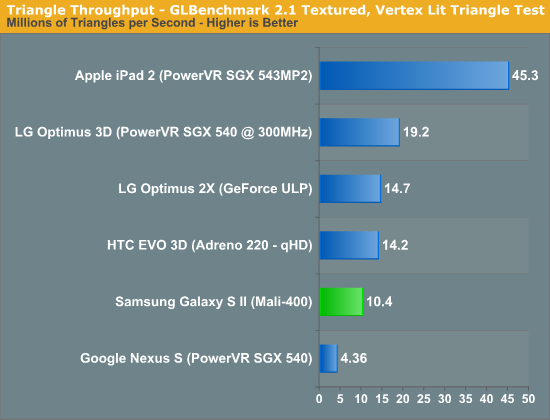
As we move to a more complex triangle test the PowerVR SGX 540 in the Optimus 3D is now only 85% faster than the Mali-400. The Nexus S' performance, despite using the same GPU, is simply abysmal. The Adreno 220 drops to only 37% faster than the Mali-400. No matter how you slice it, the 4-core Mali-400 just can't compete in geometry performance with today's GPUs. Luckily for ARM however, most mobile games aren't geometry bound - what we really need here is pixel processing power and that's something Mali-400 does deliver quite well.
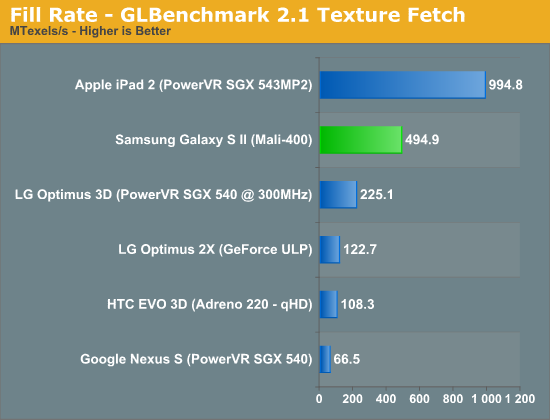
GLBenchmark 2.1's fill test paints a different picture for Mali-400. Here the SGX 540 is less than half the speed while the iPad 2's SGX 543MP2 is about twice the speed. The Mali-400's texturing performance is very solid, no GPU currently shipping in a smartphone can touch it.
What about in a game-like workload? For that we turn to the standard GLBenchmark game tests: Egypt and Pro.
GLBenchmark 2.1—as its name implies—tests OpenGL ES 2.0 performance on compatible devices. The suite includes two long benchmarking scenarios with a demanding combination of OpenGL ES 2.0 effects - texture based and direct lighting, bump, environment, and radiance mapping, soft shadows, vertex shader based skinning, level of detail support, multi-pass deferred rendering, noise textures, and ETC1 texture compression.
GLBenchmark 2.1 is the best example of an even remotely current 3D game running on this class of hardware—and even then this is a stretch. If you want an idea of how the Mali-400 stacks up to the competition however, GLBenchmark 2.1 is probably going to be our best bet (at least until we get Epic to finally release an Unreal Engine benchmark).
First let's look at the 1280 x 720 results from 2.1:
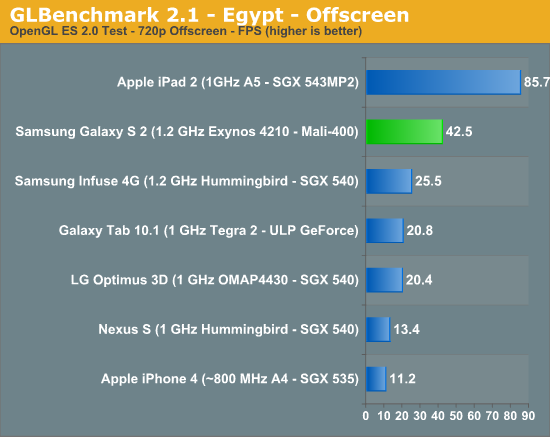
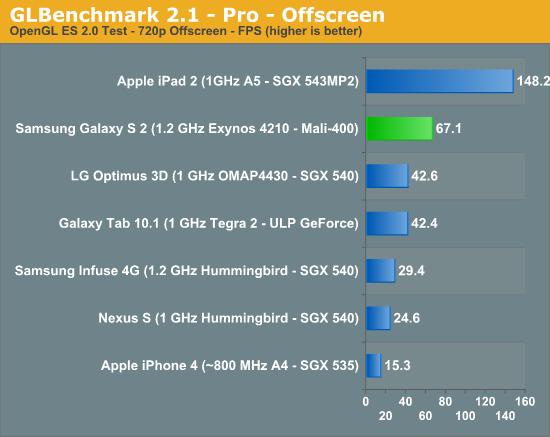
Despite huge disadvantages in geometry performance the Mali-400 does extremely well in the Egypt test, outpacing most of its competitors by a factor of 2. Only the iPad 2 is faster but that's to be expected based on the raw horsepower of its GPU. Given current workloads, ARM's Mali-400 is clearly the fastest GPU available on a smartphone today.
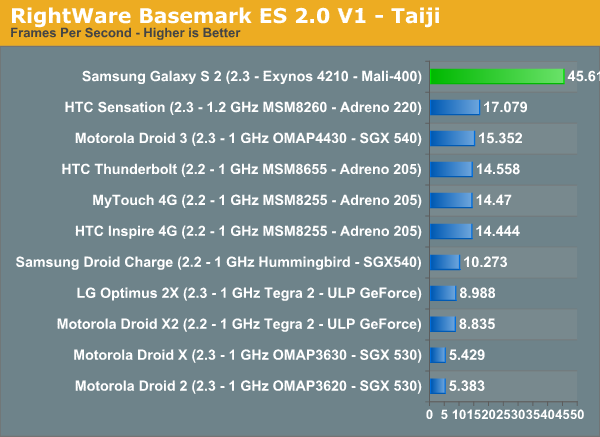
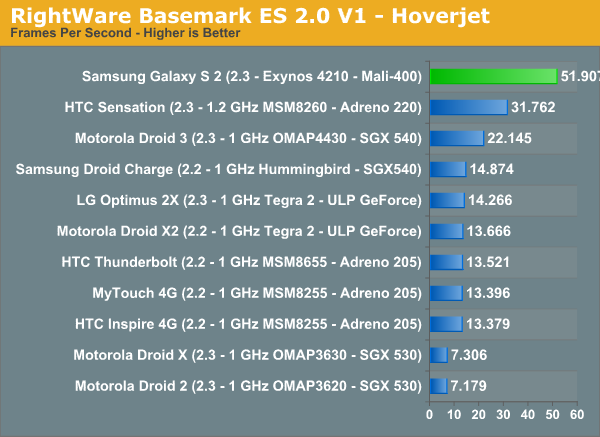
The dominance continues in the Basemark ES 2.0 tests, the Galaxy S II consistently delivers frame rates more than 2x those of its competitors. It's a shame that 3D gaming isn't a bigger deal on Android today because it'd be nice to really see ARM's high end GPU get a chance to flex its muscle on a regular basis.
For comparison to our older phones we've got our standard GLBenchmark 2.0 graphs below:
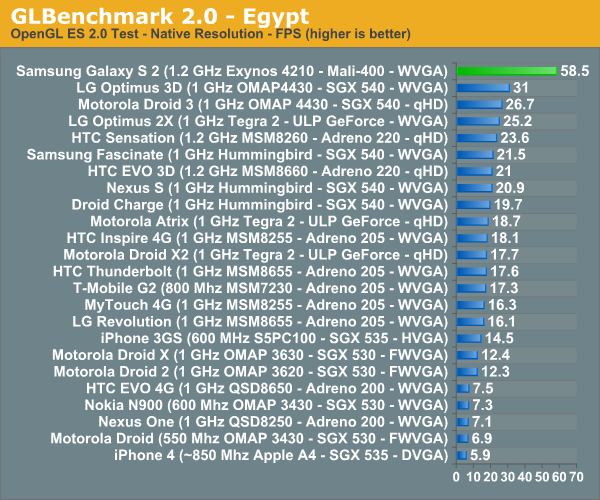

Scrolling Performance
The Galaxy S II is by far the smoothest scrolling Android device we've ever reviewed. Architecturally it has all of the right components to deliver a buttery smooth UI: gobs of memory bandwidth and a very high speed GPU. The software appears to complement it very well. Once again we turn to Qualcomm's Vellamo benchmark to quantify scrolling performance on the Galaxy S II:
| Qualcomm Vellamo Benchmark - Scrolling Performance Tests | |||||
| WVGA Unless Otherwise Noted | Ocean Flinger | Image Flinger | Text Flinger | ||
| HTC EVO 3D (Adreno 220 - qHD) | 68.98 | 26.03 | 41.79 | ||
| Motorola Photon 4G (GeForce ULP) | 62.07 | 17.64 | 35.21 | ||
| Samsung Galaxy S 4G (PowerVR SGX 540) | 55.98 | 26.27 | 31.83 | ||
| Samsung Galaxy S 2 (Mali-400 MP4) | 91.02 | 35.14 | 51.19 | ||
Vellamo produces its scores directly from frame counters, so what you're looking at is a direct representation of how fast these devices scroll through the three web tests above. The Galaxy S II is 20 - 35% faster than the Photon 4G and 45 - 100% faster than the EVO 3D. We simply have no complaints here.
Flash Performance
Thus far NVIDIA's Tegra 2 has delivered the best overall GPU accelerated Flash expierence of any SoC on the market today. With the latest update to Flash enabling NEON support on OMAP 4 both it and the Exynos 4210 now match what NVIDIA delivers here:
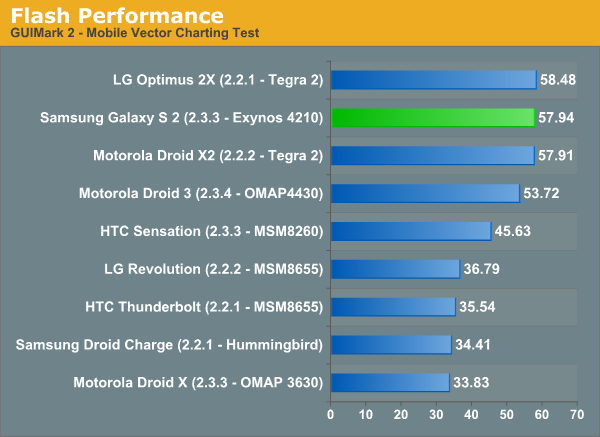
Until we hit 2012 and meet NVIDIA's Kal-El in smartphones (tablet release in 2011) and Qualcomm's first Krait designs, Samsung's Exynos 4210 looks like the best SoC for Android smartphones.










132 Comments
View All Comments
Mugur - Tuesday, September 13, 2011 - link
Well, for most Android devices I've tried (I currently own 3), if you just leave them doing nothing overnight (even with wifi on on some of them, but no 3G/HSDPA, no GPS etc.) the battery drain is like 2-3%. Of course, if some app or push email or an updating widget wakes them, the drain could reach 20-25%.You just have to play a bit with the phone and find out what is mostly consuming your battery, even get one of the "green" apps on the Market. Through experimentation, I'm sure most people (excluding the really heavy users) will get 50% more time of the battery.
wuyuanyi - Monday, September 12, 2011 - link
It must be the final answer for my pending problem.my GS II has this problem and I has been very annoyed.the CPU current produce a EMI on the output circuit ,for the BT earphone DOESN'T play such hiss and noisy.apprecite it to solve my problem rather than suspect whether it is my own case. but the next question is how to solve it ? can we manual fix the shield or , generate a noisy that is against the noisy --with reverse wave?hehe
sorry for my poor ENGLISH
awesomedeleted - Monday, September 12, 2011 - link
This is a fresh copy of my current phone...Samsung Infuse 4G...which came out in May. I hate the newer Galaxy S round home button thingy too. What's so special, the name?awesomedeleted - Monday, September 12, 2011 - link
Although I now notice a few small differences in hardware, such as 1.2Ghz Dual-core A9 vs. my Infuse's 1.2Ghz Single-core A8, and the 1GB RAM.supercurio - Monday, September 12, 2011 - link
Infuse 4G is a Galaxy S "repackaged" with a Galaxy S II look, screen and probably camera sensor for AT&T.bmgoodman - Monday, September 12, 2011 - link
So I understand that the audio quality of this phone is a step down from the original galaxy. My question is how big a step down? For a non-"audiophile" who just wants to connect the headphone jack into the AUX port on his OEM car stereo to listen to his variable bit rate MP3 (~128 bps IIRC) music collection, is this something that's likely to disappoint? Is it a notable shortcoming for a more typical music fan?supercurio - Monday, September 12, 2011 - link
No doubt cars are in general a noisy environment.Furthermore its very rare to find cars benefiting from good speakers and implementation, resulting in far from linear frequency response, left/right imbalance, resonance in other materials etc :P
Trained ears or sensible people are capable of detecting subtle difference in sound like nobody can imagine ^^ but I don't think it will Galaxy S II DAC issues described will make a noticeable difference when listening to music while driving a car for most people.
Note: I have no idea how was the original Samsung Galaxy phone on this regard, but its a regression over Galaxy S.
Headphones.. that's something else because even cheap ones (price doesn't matter) can provide some low distortion levels and let your perceive fine details.
Deusfaux - Monday, September 12, 2011 - link
It is there and does work, speaking from experience with a Nexus S.Deusfaux - Monday, September 12, 2011 - link
An HTC I used did it best though, with integrating the feature right into the browser settings. No special URL strings needed to access functionality.aNYthing24 - Monday, September 12, 2011 - link
But isn't there a version of the Tegra 2 that is clocked at 1.2 GHz? It's going to be at that clock speed in the Fusion Grid table.t